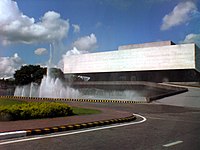User:Rajavlitra/PKP1930
Harmonious Republic of the Comorine Islands 共產國的島椰 Kungsáng Báyan sa Pulóng Kamuhirían (Karibo) | |
|---|---|
Motto: 가人한욱家, 續루마戰 Ang Katawhán ug Bayán, Károng Lúmalaban (Karibo) "The people united shall continue the struggle" National ideology: Bayanîàn | |
Anthem: 進軍的바낙히一 Tangkûàn sa Panaghîúsa "March of Unity" | |
National Seal sealofcomorines.png | |
| Location of Min in Borea Location of Min in Borea | |
| Capital | Balisdatu |
| Largest City | Salagsawin |
| Official languages | Maragat |
| Recognised national languages | Lambaknon, Kankabuloan, Tuwali, Mandayon, Uraknon |
| Demonym(s) | Comorine, Comorinian |
| Government | Federal socialist semi-presidential council republic |
• Premier | Ngon Kampilan |
| Amaya Tiringkuan | |
| Using Laonglaan | |
| Legislature | Revolutionary Congress |
| History | |
• ????? | ????? |
• ????? | ????? |
• ????? | ????? |
• ????? | ????? |
• ????? | ????? |
| Population | |
• 2018 census | 128,332,012 |
• Density | 148.68/km2 (385.1/sq mi) |
| GDP (nominal) | estimate |
• Total | 685 billion |
• Per capita | $5,341 |
| Gini | 31.55 medium |
| HDI (2013) | 0.773 high |
| Currency | Lapi (໑) (SNG) |
| Date format | MM-DD-YYYY |
| Driving side | left |
| Calling code | +63 |
| Internet TLD | .cl |
The Comorines (from Karibo: 椰國, Kamuhirian, "place of the palm trunk"), more formally the Comorine Islands and officially the Harmonious Republic of the Comorine Islands (Karibo: 共產國的島椰 Kungsáng Báyan sa Pulóng Kamuhirían) is a sovereign federal socialist state in XXX. With an estimated population of around 128.33 Million people, it is one of the most populous nations in XXX. The Comorines share a border with XXX.
Its government established after the People's Uprising of 1937 by a left wing coalition of the Comorine National Front (nationalist), the Revolutionary Worker's Party (communist) and the Congregation for People's Liberation (religious socialist), the Socialist Republic eventually overtook the formally ruling Commonwealth government in 1971 after years of political and military maneuvers. Today, the Comorines are formally guided by the state ideology of Bayanism, which combines Leninism with nationalist characteristics.
The Comorine Islands, while having opemed up to international markets and democratized in the late 90s (under the Modernization program) is still rife with authoritarianism, attacks against civil society and a low human rights record. The military and the Revolutionary Workers Party, now both constituting less than half of the government continues to be a cornerstone of Comorine politics. Some analysts also consider modern Comorines to be a continuation of institutionalized corruption that plagued the preceding commonwealth that it replaced, alongside an aggressive paranoia to percieved "imperialist" influences being deeply ingrained in society.
Taking over the preceding industrial infrastructure pre-People's War,the Comorine economy is a diarchy of urban manufacturing and rural agriculture. About a third of the economy is collectivized, a third being state-owned and another left for private and foreign investors. Observers gave noted that since the late 90s, something something rising economic inequality.
Etymology
WIP
History
WIP
Government and politics

The Comorine constitution refers to the government as a "People's vanguard with the revolutionary councils at the lead and the Central Committee as its guide", describing what could be inferred as a socialist semi-presidential republic. The upmost governmental position, the Premier is formally the convenor of the National Revolutionary Congress, who coordinates with the Central Executive Committee.
The leading party of government is the Revolutionary Worker's Party, which take up a majority of the council and the entirety of the Central Committee. Since the modernization period, other parties exist, though they constitute a minority and are required to adhere to the national ideology of Nasodismo. The RWP is the only explicit Leninist party.
Foreign relations
WIP
Military

The People's Revolutionary Army (PRA, Kasundalohan sa Katawhang Rebolusyonaryo, Soldão Rebolusyonaryo del maga Hente) is the armed forces of Comorines which is composed of five major components, namely: the Ground Forces (PRAGF), the Air Force (PRAAF), the Navy (PRAN), the Rocket Forces (PRARF), and the Coast Guard (PRACG). Furthermore, it is supplemented by the People's Commission of Revolutionary Affairs (Komisyon Hente del Asunto Revolusyonaryo), a paramilitary organization serving directly under the Central Executive Committee of the Comorines, serving both as the state's guerilla force and interior ministry.
As of 2018, the PRA have around 500,000 men in active service, however, it is estimated that the PRA's total strength including its paramilitary units have figures as high as 4,500,000. In 2016, official state data stated that Comorines' military expenditure is approximately $17.125 Billion USD or 2.5% of the country's GDP, which is the highest military Comorines' highest military spending since [historical event] as the country makes attempts to modernize its aging armed forces.
Administrative divisions
WIP
Economy
WIP
Transportation

Most of the Comorines's transportation infrastructure are state operated. Due to geographical location something something, transportation is relatively underdeveloped.
The most popular type of transport in Comorines is the Kahente (People's Truck), which most, if not all, are operated by state-owned entities under the People's Committee of Transporation.
Demographics
WIP
Languages
WIP
Religion
WIP
Culture
WIP
Sports
WIP
Education
WIP
